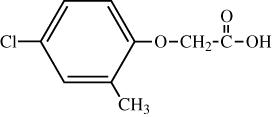|
|
|
 |
|
| MCPA |
Action / Use
ACTION: Herbicide.
USE: For use in peas, rice, small grains, sugarcane, grassland, pastures, tree crops, turf, and noncrop areas for postemergent control of many broadleaf weeds.
FORMULATIONS: Potassium, sodium, dimethylamine salts (water soluble concentrates); isooctyl, isobutylesters (emulsifiable concentrates).
PREMIX PARTNERS: Benazolin; Bentazone; Bromoxynil; Carfentrazone-ethyl; Clopyralid; 2,4-D; 2,4-DB; Dicamba; Dichlorprop; Dichlorprop-P; Fenoxaprop-P-ethyl; Florasulam; Fluroxypyr; Glyphosate; Imazamox; Ioxynil; MCPB; Mecoprop; Mecoprop-P; Picolinafen; Propanil; Pyrasulfotole; Triclopyr. |
| Identification |
| COMMON NAME: MCPA (ISO, BSI, WSSA); 2,4-MCPA (France); Metaxon (USSR). |
|
Chemistry |
COMPOSITION: (4-chloro-2-methylphenoxy)acetic acid((1)1).
CLASS: Phenoxy herbicide.
PROPERTIES: White to light brown solid, flakes, crystal powder or liquid. Same as 2,4-D except for replacement of one chlorine atom by a methyl group. Melting point 114-119℃. Vapor pressure 7.7 x 10-6 mbar. Non-corrosive. Solubility: At 20-25℃. in ethanol 150 g/l; acetone >200 g/l. Pol-Chwastox Extra*: Density 1.18-1.21 g/ml at 20℃.
 |
|
Environmental Guidelines |
HAZARDS: Fish: LC50 117 mg/l (trout). Bird: LD50 377 mg/kg (bobwhite quail). Bee: Nontoxic.
WATER SOLUBILITY: Room temperature, 825 ppm. |
| Safety Guidelines |
TOXICITY: (Rat): Oral LD50 900-1160 mg/kg; Inhalation LC50 >6.36 mg/l. (Mouse): Oral 550 mg/kg. (Rabbit): Dermal LD50 >4000 mg/kg. Pol-Chwastox Extra*: (Rat): Oral LD50 1914 mg/kg.
HANDLING/STORAGE CAUTIONS: Avoid contact with skin, eyes, and respiratory tract. Causes irreversible eye damage. Harmful if swallowed. Avoid breathing dust. Avoid spray drifts onto susceptible plants such as cotton, grapes, and tomatoes. Do not contaminate water for irrigation or domestic use. Do not transport or store near fertilizers, seeds, insecticides, or fungicides. Amine salt stable indefinitely. Ester stability depends upon formulations. Reacts with alkalis to form salts.
SPILL CONTROL/CLEANUP: Large liquid spillage should be dammed-off and pumped into containers; soak up remainder with absorbent material and dispose of in accordance with local regulations. Solid spillage should be picked up with an industrial vacuum cleaner.
PRODUCT/WASTE DISPOSAL: Dispose of by special means (suitable incineration, etc.) in accordance with local regulations. | |
|

